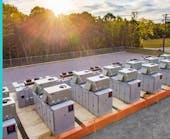The grid isn’t ideal for supporting advanced green power technologies, but sweeping legislation and national goals make conversations more urgent. Renewable energy integration could happen, but installers may find it causes the grid to overload.
New battery designs can help the transition to a smarter, greener grid. Environmental progress will halt if planners don’t incorporate intermediary solutions while the rest of the infrastructure catches up.
What the New Battery Design Offers
A revolutionary battery design could change renewable energy integration for a more seamless, sustainable future because it can increase public buy-in. One of the points of public resistance against batteries is how much pressure they put on the environment during raw material extraction — consider the discussions surrounding lithium-ion batteries for electric vehicles.
Grid batteries need a plentiful resource that can power them without causing too much damage and invalidating their green intentions—that’s where sodium and aluminum come in.
The battery, being developed by the Pacific Northwest National Laboratory, removes necessary metals like nickel and instead focuses on melting down salt until it’s acidic and molten. The byproduct of the battery’s reactions gives it a higher capacity. Increasing the capacity is crucial for optimizing the specific energy density, or the battery’s ability to release power to the rest of the grid.
The shape is another critical factor in its impact. It’s flexible, and designers can form it for specific locations. The flat cathode and anode surrounding the aluminum wool and molten salt could be thicker, allowing scientists to experiment with capacity and discharge speeds with simple blueprint adjustments.
Sodium is abundant, and scrap aluminum will be easy to come by if battery makers reach out to relevant industries to upcycle what would otherwise go to landfill. Collaborations like this make battery production less expensive as resources and labor that go into material extraction could be eliminated.
It also transforms industries previously wrought with environmentalist concerns, like aluminum, reallocating it to renewable energies. It allows manufacturers to develop more batteries, making grid advancement and renewable energy adoption easier to afford and fathom on a large scale in short time frames.
How Batteries Can Catalyze Renewable Energy Integration
Balance is the most significant issue in the next generation of grid technology. Renewable energy generation is infinite, as panels can harvest solar anywhere there’s sunlight and the tides can reliably turn underwater turbines. Sometimes, this leads to power deficits if nature isn’t cooperating and other regions have surpluses. The grid has to be able to store extra energy to disperse it according to peak times and emergency scenarios.
Energy storage and management are almost as vital as generating electricity from renewable sources. It will be the key to streamlined scaling.
A green grid can’t achieve this without eco-friendly and optimized battery systems that the current grid can already handle. One matter is creating the ideal battery storage solution for the world’s idealized, environmentally friendly future. Still, something has to work in the meantime to accept rapid renewable energy adoption.
A new battery design isn’t enough to support needed grid resilience during the transition. As with many eco-friendly technologies, it will require synergy with other assets like green transformers and Internet of Things (IoT) sensors. This would enable it to distribute energy appropriately, especially when buildings consume 40% of the nation’s power alone.
How Batteries Will Unlock Grid Modernization
Renewable energy acceptance is one side effect of durable, trustworthy grid batteries. However, it will also reveal how essential modernization is to regulatory bodies and corporations. There is a need for standardization, goals and compliance to hold infrastructure influencers accountable for making changes that can support the new battery design to promote sustainability.
The sodium-based battery could show industries how to scale cities and provide insight into the future if more parties committed to and invested in grid modernization. Upgrading critical infrastructure is vital for renewable energy accessibility, but also for:
● Increasing remote work access
● Bolstering infrastructure cybersecurity
● Becoming more resilient against natural disasters
● Protecting infrastructure-critical data
Batteries are also the key to automating transitions to renewable energy stores. Designers who program batteries while implementing technology like AI and machine learning to gather data can help communities with little human intervention. It will allow other workers to dedicate time and resources for further grid planning in the face of growing natural disasters and political distress. The new battery could activate when needed, and tests suggest its design can run solar power for 10 to 24 hours.
How Renewable Energy Integration Keeps Momentum
The new battery design spells out promising aspirations for environmentalists and city planners alike. It could motivate more parties to invest in renewable energy and grid batteries than ever before. Several critical roadblocks in greener grid adoption disappear in the face of a smarter, more compatible battery. Time and testing will determine how it can grow to hold more power and release energy on an intelligent clock.
-- -- --
Read more from Emily Newton at EnergyTech.com
Four Efficient Walls: Strategies for Commercial Buildings to reduce Energy Costs
How to Break Down Barriers to Energy Efficiency in Health Care?
What can Universities do to earn an A+ in Renewable Energy use?






